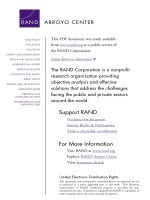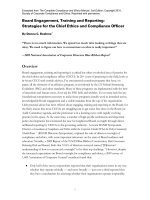MULTIPLE SCLEROSIS CURRENT STATUS AND STRATEGIES FOR THE FUTURE ppt
Bạn đang xem bản rút gọn của tài liệu. Xem và tải ngay bản đầy đủ của tài liệu tại đây (3.06 MB, 457 trang )
Janet E. Joy and Richard B. Johnston, Jr., Editors
Committee on Multiple Sclerosis:
Current Status and Strategies for the Future
Board on Neuroscience and Behavioral Health
INSTITUTE OF MEDICINE
NATIONAL ACADEMY PRESS
Washington, D.C.
MULTIPLE
SCLEROSIS
CURRENT STATUS AND
STRATEGIES FOR THE FUTURE
NATIONAL ACADEMY PRESS • 2101 Constitution Avenue, N.W. • Washington, DC 20418
NOTICE: The project that is the subject of this report was approved by the Governing Board of the
National Research Council, whose members are drawn from the councils of the National Academy of
Sciences, the National Academy of Engineering, and the Institute of Medicine. The members of the
committee responsible for the report were chosen for their special competencies and with regard for
appropriate balance.
Support for this project was provided by the National Multiple Sclerosis Society. The views
presented in this report are those of the Institute of Medicine Committee on Multiple Sclerosis:
Current Status and Strategies for the Future and are not necessarily those of the funding agencies.
Additional copies of this report are available for sale from the National Academy Press, 2101
Constitution Avenue, N.W., Box 285, Washington, D.C. 20055. Call (800) 624-6242 or (202) 334-
3313 (in the Washington metropolitan area), or visit the NAP’s home page at www.nap.edu. The full
text of this report is available at www.nap.edu.
For more information about the Institute of Medicine, visit the IOM home page at:
www.iom.edu.
Library of Congress Cataloging-in-Publication Data
Multiple sclerosis : current status and strategies for the future /
Janet E. Joy and Richard B. Johnston, Jr., editors.
p. ; cm.
Includes bibliographical references and index.
ISBN 0-309-07285-9 (hardcover)
1. Multiple sclerosis.
[DNLM: 1. Multiple Sclerosis—therapy. 2. Multiple
Sclerosis—physiopathology. 3. Research. WL 360 M956378 2001] I. Joy,
Janet E. (Janet Elizabeth), 1953- II. Johnston, Richard B., 1935-
RC377 .M8455 2001
616.8′34—dc21
2001002431
Copyright 2001 by the National Academy of Sciences. All rights reserved.
Printed in the United States of America.
The serpent has been a symbol of long life, healing, and knowledge among almost all cultures
and religions since the beginning of recorded history. The serpent adopted as a logotype by the
Institute of Medicine is a relief carving from ancient Greece, now held by the Staatliche Museen in
Berlin.
“Knowing is not enough; we must apply.
Willing is not enough; we must do.”
—Goethe
INSTITUTE OF MEDICINE
Shaping the Future for Health
The National Academy of Sciences is a private, nonprofit, self-perpetuating society of
distinguished scholars engaged in scientific and engineering research, dedicated to the
furtherance of science and technology and to their use for the general welfare. Upon the
authority of the charter granted to it by the Congress in 1863, the Academy has a mandate
that requires it to advise the federal government on scientific and technical matters. Dr.
Bruce M. Alberts is president of the National Academy of Sciences.
The National Academy of Engineering was established in 1964, under the charter of the
National Academy of Sciences, as a parallel organization of outstanding engineers. It is
autonomous in its administration and in the selection of its members, sharing with the
National Academy of Sciences the responsibility for advising the federal government. The
National Academy of Engineering also sponsors engineering programs aimed at meeting
national needs, encourages education and research, and recognizes the superior achieve-
ments of engineers. Dr. William A. Wulf is president of the National Academy of Engi-
neering.
The Institute of Medicine was established in 1970 by the National Academy of Sciences
to secure the services of eminent members of appropriate professions in the examination
of policy matters pertaining to the health of the public. The Institute acts under the respon-
sibility given to the National Academy of Sciences by its congressional charter to be an
adviser to the federal government and, upon its own initiative, to identify issues of medical
care, research, and education. Dr. Kenneth I. Shine is president of the Institute of Medi-
cine.
The National Research Council was organized by the National Academy of Sciences in
1916 to associate the broad community of science and technology with the Academy’s
purposes of furthering knowledge and advising the federal government. Functioning in
accordance with general policies determined by the Academy, the Council has become the
principal operating agency of both the National Academy of Sciences and the National
Academy of Engineering in providing services to the government, the public, and the
scientific and engineering communities. The Council is administered jointly by both Acad-
emies and the Institute of Medicine. Dr. Bruce M. Alberts and Dr. William A. Wulf are
chairman and vice chairman, respectively, of the National Research Council.
National Academy of Sciences
National Academy of Engineering
Institute of Medicine
National Research Council
v
COMMITTEE ON MULTIPLE SCLEROSIS: CURRENT STATUS AND
STRATEGIES FOR THE FUTURE
RICHARD B. JOHNSTON, JR. (Chair), Professor of Pediatrics, National Jewish
Medical and Research Center, University of Colorado School of Medicine
JACK P. ANTEL, Professor of Neurology and Neurosurgery, Montreal
Neurological Hospital and Institute, McGill University, Quebec, Canada
SAMUEL BRODER, Executive Vice President for Medical Affairs, Celera
Genomics, Rockville, Maryland
JESSE M. CEDARBAUM, Vice President of Clinical Affairs, Regeneron
Pharmaceuticals, Tarrytown, New York
PATRICIA K. COYLE, Professor of Neurology, State University of New York,
Stony Brook
STEPHEN L. HAUSER, Professor of Neurology, University of California, San
Francisco School of Medicine
LISA I. IEZZONI, Professor of Medicine, Harvard Medical School, Beth Israel
Deaconess Medical Center, Boston, Massachusetts
SUZANNE T. ILDSTAD, Director of Institute for Cellular Therapeutics, University
of Louisville, Kentucky
SHARON L. JULIANO, Professor of Anatomy and Cell Biology and
Neurosciences Program, Uniformed Services University of the Health
Sciences, Bethesda, Maryland
DONALD L. PRICE, Professor of Pathology, Neurology and Neuroscience, Johns
Hopkins University School of Medicine, Baltimore, Maryland
RAYMOND P. ROOS, Professor of Neurology, University of Chicago, Illinois
ALAN J. THOMPSON, Professor of Neurology, University College, London,
England
STEPHEN G. WAXMAN, Professor of Neurology, Yale Medical School, New
Haven, Connecticut
HARTMUT WEKERLE, Director, Max-Planck-Institut fur Neurobiologie, Planegg-
Martinsreid, Germany
Study Staff
JANET E. JOY, Study Director
JOHN A. ROCKWELL, Research Assistant
AMELIA B. MATHIS, Project Assistant
LINDA LEONARD, Administrative Assistant (until 9/2000)
LORA K. TAYLOR, Administrative Assistant (from 9/2000)
TERRY C. PELLMAR, Board Director
CARLOS GABRIEL, Financial Associate
vi
BOARD ON NEUROSCIENCE AND BEHAVIORAL HEALTH
ANN M. GRAYBIEL (Chair), Massachusetts Institute of Technology, Cambridge
KENNETH B. WELLS (Vice-Chair), Neuropsychiatric Institute, University of
California, Los Angeles
NANCY E. ADLER, University of California, San Francisco
RICHARD J. BONNIE, University of Virginia School of Law, Charlottesville
WILLIAM E. BUNNEY, University of California, Irvine
RICHARD G. FRANK, Harvard Medical School, Boston, Massachusetts
JEROME KAGAN, Harvard University, Cambridge, Massachusetts
HERBERT D. KLEBER, Columbia University and New York State Psychiatric
Institute, New York, New York
BEVERLY B. LONG, World Federation for Mental Health, Atlanta, Georgia
KATHLEEN R. MERIKANGAS, Yale University, New Haven, Connecticut
STEVEN M. MIRIN, American Psychiatric Association, Washington, D.C.
STEVEN M. PAUL, Lilly Research Laboratories, Indianapolis, Indiana
DAVID REISS, George Washington University Medical Center, Washington, D.C.
RHONDA J. ROBINSON-BEALE, Blue Cross/Blue Shield of Michigan, Southfield
STANLEY J. WATSON, University of Michigan, Ann Arbor
STEPHEN G. WAXMAN, Yale Medical School, New Haven, Connecticut
NANCY S. WEXLER, Columbia University, New York, New York
ANNE B. YOUNG, Massachusetts General Hospital, Boston
vii
Preface
Multiple sclerosis (MS) is not a new disease. Its effects on the brain were
described in the 1830s, and it was identified as a distinct clinical entity in the
1860s. In fact, writings from the Middle Ages appear to describe individuals with
this condition. MS is the most common neurological disorder of young adults;
there are approximately 350,000 people with MS in the United States and an
estimated 2 million patients worldwide.
Research on the disorder has been energetic over recent decades. In 1996, the
U.S. National Institutes of Health (NIH) spent almost $83 million on MS re-
search. This sum exceeded the NIH expenditure that year on asthma, tuberculo-
sis, or cervical cancer. MS has not been neglected by researchers in this country
or worldwide.
As a result, important progress has been made in defining the pathologic
changes of MS, in using new imaging techniques for evaluation, and in develop-
ing treatments that can modify its course. Yet, despite concerted effort on the part
of many good researchers, the fundamental elements of MS are still not under-
stood, and the path toward consistently preventing its progression or curing it
remains obscure. For example, we do not know what causes MS to appear in one
person and not another. We do not know what role genes play. We have known
for decades that MS has a widely variable clinical expression and unpredictable
course, but do the variations reflect different causative agents or different re-
sponses to the same basic cause? Most investigators consider MS to be an au-
toimmune disease, but what incites the autoimmune response—a change in the
cells of the nervous system so that they appear foreign or a microbial agent that
mimics a cell component? Why is it approximately twice as common in women
viii PREFACE
as in men? How can we most effectively relieve the various troubling symptoms
of MS such as pain and fatigue? How can we help people with MS adapt to the
disease and live their lives to the fullest level possible?
The National Multiple Sclerosis Society was founded in 1946 to address
these and other questions about MS. Its mission is simple and forthright: “To end
the devastating effects of multiple sclerosis.” Through the efforts of its 650,000
members and staff, it has made extraordinary contributions to understanding MS
by a series of highly imaginative programs in research and patient services,
including almost $300 million in research grants. The report that you see here is
the result of a request from the Society to the Institute of Medicine (IOM) for
guidance in developing a strategic plan to direct future investments in MS re-
search.
The multidisciplinary committee convened by the IOM in response to this
request was charged to review current knowledge of all aspects of MS from cells
to symptoms; to identify techniques, resources, and innovations used outside the
field that might be applied to the MS challenge; and to recommend strategies that
might push MS research forward most effectively.
To address its charge, the committee, with the support of IOM staff, re-
viewed the scientific literature related to all aspects of MS and received input
from 45 outside consultants: 9 of these wrote state-of-the-art commentaries on
symptom management, some told us what they needed most as MS patients, and
17 described the newest science during three workshops. Most of the workshop
participants were not primarily involved in MS research or with MS patients but
agreed to brainstorm with us about how the best of their disciplines might be
applied to MS. We clearly could not have accomplished our work without the
help of these consultants, and their listing in the Acknowledgments badly under-
states our gratitude. Finally, the committee recognizes with the deepest apprecia-
tion the support given by the extraordinary staff assigned to us by the IOM—
Janet Joy, John Rockwell, Amelia Mathis, and Terry Pellmar. In particular, Janet
Joy, study director and neuroscientist by training, with intelligence, humor, and
an exceptional intensity of commitment, inspired and guided us to the completion
of our task.
Richard B. Johnston, Jr., M.D.
Chair
ix
Acknowledgments
People live with multiple sclerosis (MS) for decades, making it a disease of
selves as well as cells. The committee’s assessment of the current status of
progress against MS thus entailed a review from biomedical perspectives, as well
as from psychological and social perspectives. This massive undertaking could
not have been accomplished without the help of an array of experts as multi-
faceted as the disease itself. The committee is deeply indebted to these many
people for their valuable contributions.
The following people wrote invaluable background papers for the commit-
tee: Dedra Buchwald (fatigue), Howard Fields (pain), Robert W. Hamill (bladder
and bowel control), David E. Krebs (assistive technology), T. Jock Murray (cog-
nitive impairment), Peggy Neufeld (assistive technology), Trevor Owens (ge-
netic animal models), Robert G. Robinson (depression and brain injury), William
Z. Rymer (spasticity and weakness), and Marca Sipski (sexual function).
Another group presented a series of excellent talks on new approaches to MS
research at workshops for the committee. This group includes Mindy Aisen,
Michael Conneally, Scott E. Fraser, Chien Ho, Ole Isacson, Elliott D. Kieff,
Jeffery Kocsis, Henry McFarland, Deborah Miller, Rhona Mirsky, Marc
Peschanski, John C. Roder, Jay Siegel, Joy Snider, Lawrence Steinman, Barbara
Vickrey, and Michael Weinrich. (Topics are listed individually in Appendix C.)
The following people provided technical comments on draft sections of the
report: Robert Burke, Mary Horwitz, Peggy Neufeld, John Roder, and Richard
Rudick. Still others served as technical consultants either in meetings with the
committee, sharing unpublished reports, or in consultations with Institute of Medi-
x ACKNOWLEDGMENTS
cine (IOM) staff. This group includes Elaine Collier, Gary Karp, Lorna Layward,
Ian McDonald, Sarah Minden, Audrey Penn, and Albert van der Pol.
All of these people gave generously of their time and made a tremendous and
much appreciated contribution to the breadth and depth of this report.
Stephen Reingold, Vice President of Scientific Programs, and Nicholas
LaRocca, Director of Health Care Delivery and Policy Research, at the National
Multiple Sclerosis Society were indispensable to the committee’s efforts. They
provided the committee with volumes of background material and fielded an
endless stream of inquiries from IOM staff. They were unfailingly quick to reply
to queries and provided stores of information.
Miriam Davis and Jane Durch provided substantive editing for sections of
the report, Amy Fluet wrote material for several of the explanatory boxes in the
report, and Florence Poillon edited the uncorrected proofs. Each of them greatly
enhanced the readability of the report and we are grateful for their excellent work.
This report has been reviewed in draft form by individuals chosen for their
diverse perspectives and technical expertise, in accordance with procedures ap-
proved by the National Research Council’s Report Review Committee. The pur-
pose of this independent review is to provide candid and critical comments that
will assist the institution in making the published report as sound as possible and
to ensure that the report meets institutional standards for objectivity, evidence,
and responsiveness to the study charge. The review comments and draft manu-
script remain confidential to protect the integrity of the deliberative process. We
wish to thank the following individuals for their participation in the review of this
report:
Fred Barkhof, Diagnostic Radiology, Vrije Universiteit Hospital, Amsterdam,
Netherlands
George Ebers, Professor, Department of Clinical Neurology, Oxford
University
Jill S. Fischer, Director, Psychology Program (1985-2000), Mellen Center for
MS Treatment and Research Cleveland Clinic
Zach W. Hall, Vice Chancellor, Office of Research, University of California,
San Francisco
Charles A. Janeway, Jr., Department of Immunobiology, Yale School of
Medicine
Alan M. Jette, Dean, Sargent College of Health and Rehabilitation Services,
Boston University
Jurg Kesselring, Professor and Head, Department of Rehabilitation Centre,
Valens, Switzerland
Samuel K. Ludwin, Professor, Pathology Department, Queens University,
Ontario, Canada
Robert H. Miller, Associate Professor, Case Western Reserve University
School of Medicine
ACKNOWLEDGMENTS xi
Mary Beth Moncrief, Manager, Associate National Scientific Program
Juvenile Diabetes Foundation International
John Newsom-Davis, Professor, Clinical Neurology, University of Oxford
Michael B.A. Oldstone, Professor, Department of Neuropharmacology,
Division of Virology, The Scripps Research Institute
Jerry Wolinsky, Professor, Department of Neurology, University of Texas,
Houston Medical Center Health Science Center
Although the individuals listed above have provided constructive comments
and suggestions, they were not asked to endorse the conclusions or recommenda-
tions nor did they see the final draft of the report before its release. The review of
this report was overseen by Joseph B. Martin, Dean, Harvard Medical School and
Floyd R. Bloom, Chair, Department of Neuropharmacology, the Scripps Re-
search Institute, who were responsible for making certain that an independent
examination of this report was carried out in accordance with institutional proce-
dures and that all review comments were carefully considered. Responsibility for
the final content of this report rests entirely with the Committee on Multiple
Sclerosis: Current Status and Strategies for the Future and the Institute of Medi-
cine.
xiii
Contents
EXECUTIVE SUMMARY . . . . . . . . . . . . . . . . . . . . . . . . . . . . . . . . . . . . . . . 1
1 INTRODUCTION . . . . . . . . . . . . . . . . . . . . . . . . . . . . . . . . . . . . . . . . . . 17
The U.S. National Multiple Sclerosis Society, 19
Recent Advances in MS, 21
Origin of the Study, 21
Previous Reviews of MS Research Programs, 22
The IOM Committee and Its Mandate, 24
How the Committee Carried Out its Task, 26
Organization of the Report, 26
References, 27
2 CLINICAL AND BIOLOGICAL FEATURES . . . . . . . . . . . . . . . . . . 29
The Clinical Picture: Symptoms, Disease Course, Variation,
and Diagnosis, 29
Underlying Disease Mechanisms, 54
Animal Models of MS, 90
References, 104
3 CHARACTERISTICS AND MANAGEMENT OF
MAJOR SYMPTOMS . . . . . . . . . . . . . . . . . . . . . . . . . . . . . . . . . . . . . 115
Cognitive Impairment, 115
Depression, 120
Spasticity and Weakness, 128
xiv CONTENTS
Ataxia and Tremor, 138
Bladder and Bowel Dysfunction, 140
Visual Disturbances, 148
Fatigue, 149
Sexual Dysfunction, 155
Pain, 158
References, 166
4 DISEASE MANAGEMENT AND MEASUREMENT . . . . . . . . . . . 177
Living with MS, 178
Measuring Functional Status and Quality of Life, 193
Assistance, 205
Information and Communication, 216
Health Care, 221
References, 229
5 STRATEGIES FOR FUTURE RESEARCH ON
DISEASE MECHANISMS . . . . . . . . . . . . . . . . . . . . . . . . . . . . . . . . . . 241
Technologies and Research Strategies, 267
References, 272
6 FUTURE STRATEGIES FOR THERAPIES . . . . . . . . . . . . . . . . . . 277
Strategies for Disease Modification, 278
Challenges in MS Clinical Trials, 298
Shared Resources, 312
References, 318
7 BUILDING AND SUPPORTING THE RESEARCH
ENTERPRISE . . . . . . . . . . . . . . . . . . . . . . . . . . . . . . . . . . . . . . . . . . . . 325
Research Funding, 325
Human Resources, 333
Infrastructure, 339
Clinical Trials, 340
Biotechnology and Pharmaceutical Firms, 341
Health Care Research, 343
Role of Voluntary Health Organizations, 344
References, 346
8 RECOMMENDATIONS . . . . . . . . . . . . . . . . . . . . . . . . . . . . . . . . . . . 347
Etiology and Pathogenesis, 348
Tools for Research and Diagnosis, 355
Therapeutics, 358
CONTENTS xv
Health Status and Quality of Life, 361
Research Enterprise, 363
References, 367
APPENDIXES
A Committee and Staff Biographies, 371
B List of Expert Consultants, 377
C Workshop Agendas, 379
D Kurtzke’s Expanded Disability Status Scale, 385
E Drugs Used in the Treatment of MS, 387
F U.S. Social Security Administration’s Criteria for Qualifying as
Disabled from MS, 401
G Treatments That Have Been Claimed to Be of Benefit in MS, 405
INDEX . . . . . . . . . . . . . . . . . . . . . . . . . . . . . . . . . . . . . . . . . . . . . . . . . . . . . . 413
xvii
List of Tables and Figures
TABLES
2.1 Varieties of MS, 30
2.2 Initial Signs and Symptoms of MS, 32
2.3 Prognostic Relapse Indicators, 34
2.4 Information Provided by Neuroimaging, 38
2.5 Proposed CSF Disease Markers in MS, 44
2.6 Poser Diagnostic Criteria for MS, 46
2.7 MRI Criteria for Definite MS, 46
2.8 Evoked Potentials as a Diagnostic Tool in MS, 47
2.9 Disease-Modifying Therapies for Relapsing MS, 49
2.10 Clinical Pathological Correlations in Common Syndromes of MS, 62
2.11 Selected Diseases That Are Believed to Be Autoimmune Based, 69
2.12 Possible Autoantigens in MS, 71
2.13 CNS Demyelinating Diseases That Resemble MS, 85
2.14 Koch’s Postulate on Causations of Disease by a Pathogen, 88
2.15 Agents Isolated or Implicated in the Etiology of MS, 89
2.16 Animal Models of MS, 91
2.17 Comparison Between Multiple Sclerosis and EAE, 92
2.18 Animal Viruses That Induce Demyelination, 96
3.1 Medications Used to Treat Depression, 124
3.2 Depression and Beta-Interferon, 126
3.3 Medications Used to Treat Spasticity, 134
3.4 Indications of Bladder Dysfunction, 141
xviii LIST OF TABLES AND FIGURES
3.5 Medications Used to Treat Bladder and Bowel Dysfunction, 144
3.6 Medications Used to Treat Optic Neuritis and Abnormal Eye
Movements, 150
3.7 Medications Used to Treat Fatigue, 154
3.8 Neurological Pathways That Control Sexual Response in Men and
Women, 157
3.9 Medications Used to Treat Erectile Dysfunction, 159
5.1 Hypothetical Results of a Clinical Trial, 262
6.1 MRI Outcomes for Clinical Trials, 310
7.1 Research Budgets of Selected Health Organizations in 1998, 329
FIGURES
1.1 MS distribution map, 18
1.2 The nerve fiber in multiple sclerosis, 19
2.1 Spectrum of disease course, 31
2.2 Areas of the CNS affected by MS, 32
2.3 MRI scans of the brain, 37
2.4 Oligodendrocyte making myelin, 55
2.5 Pathogenesis, 57
2.6 Axonal transection and degeneration, 59
2.7 Possible mechanisms of demyelination, 61
2.8 The blood-brain barrier, 63
2.9 Interactions between major cell components of the immune system, 68
2.10 Possible mechanism of viral etiology, 70
3.1 Functions controlled by nerves at different levels of the spine, 129
5.1 Demyelination and axonal degeneration in multiple sclerosis, 242
5.2 Possible role of AMPA/kainate receptors on neurons and glia, 244
6.2 Lineage of neural stem cells, 294
7.1 Relationship between NIH disease-specific research funding, 327
7.2a Summary of publications in general medical journals, 328
7.2b Summary of publications in neurology journals, 330
7.3 Ph.D and postdoctoral fellowship trends, 335
7.4 Trends in postdoctoral fellowship applications, 337
1
Executive Summary
Multiple sclerosis (MS) is a complex disease that has been much more
difficult to cure than was expected when the National Multiple Sclerosis Society
(the MS Society) was founded in 1946 by Sylvia Lawry “to end the devastating
effects of multiple sclerosis.” Yet optimism is possibly greater than it has ever
been since those early years, in large part due to the development of the first
treatments that can slow the progress of MS. Services for people with MS have
also improved. “Diagnose and adios,” Labe Scheinberg’s famously disparaging
quote about the options available to MS neurologists in the 1970s, no longer rings
true. Nor does the advice to young researchers that “if you want to ruin your
career, go into MS.” Much has changed since 1946. Still, no cause or cure for MS
has been found. It remains a mysterious disease with no known pathogen or even
known determinants of its severity and course.
MS is not alone in this regard. Neurological diseases are among the most
difficult to study, and although beneficial therapies have been developed in the
last decades for Parkinson’s disease, Alzheimer’s disease, and epilepsy, there is
still no cure for any of the degenerative neurological diseases. Advances on key
fronts, such as improved ability to create images of the living brain and spinal
cord, new understanding of the brain’s capacity for repair, and an overall acceler-
ated pace of new discoveries about the cellular machinery of the brain, have
renewed the optimism of many investigators about the possibility of developing
effective therapeutic strategies for MS patients. New therapeutic strategies, such
as gene therapy, stem cell transplantation, and neuroprotection strategies, rising
on the horizon have emerged from recent advances in these areas.
2 MULTIPLE SCLEROSIS
Over the years, the specific targets of MS research have been refocused and
revised. The MS Society has reconsidered and remained committed to its focus
on research. At the same time, the scope of research topics has expanded, as have
perspectives of the Society’s role. Although MS research has traditionally been
conducted on behalf of patients who remained in the background, now—to a
small, but increasing degree—patient perspectives have stimulated new areas of
research. New disciplines have emerged. Health care policy, functional status
measurement, and quality-of-life assessment are all relatively new areas of re-
search and are critically important for improving the lives of people with MS.
The spectrum of current MS research ranges from strategies to develop treat-
ments that impede the disease process, to treatments for specific symptoms, to
research aimed at promoting successful adaptations to the illness, including opti-
mizing the abilities of people with MS to function in their daily lives.
In December 1998, the National Multiple Sclerosis Society asked the Insti-
tute of Medicine to undertake a strategic review of MS research on its behalf.
This report presents the research strategies and programs that the committee
believes are likely to be the most productive and most important in the near
future. Throughout the study, the committee sought to identify windows of op-
portunity for research, such as those created by new discoveries about the self-
repair mechanisms of the brain or new disease-specific changes in gene activa-
tion. The committee also sought to identify research needs where the windows of
opportunity are less transparent, such as the development of evidence-based ap-
proaches to address varied information needs of people with MS and to treat the
fatigue and pain that so often accompany MS. Ideas for the future are built on the
review of current knowledge and gaps in the biomedical and social science of
MS. The intended audience of this report includes the architects and developers
of MS research programs, as well as people with MS and their families who want
to learn what is currently known about MS and what might lie ahead.
The report covers three broad areas: (1) biomedical aspects of the disease,
causes, course, and treatments (Chapters 2, 5, and 6); (2) adaptation and manage-
ment (combination of medical, technological, and psychosocial aspects) (Chap-
ters 3 and 4); and finally, (3) proposals for research managers to facilitate re-
search progress (Chapter 7).
DISEASE CAUSES, COURSE AND TREATMENTS
The ultimate goal of research in MS is the development of interventions that
can improve the lives of those living with MS and can prevent or cure MS.
However, understanding of the MS disease process is not yet sufficient to predict
which therapeutic strategies will be most effective. Although the new disease-
modifying drugs are a major leap forward, it is important to remember that they
are not a cure, nor are they effective for all patients. The recommendations
EXECUTIVE SUMMARY 3
described below summarize the committee’s conclusions about which directions
appear most likely to provide the fundamental knowledge that can lead to the
development of effective therapies (see Box 1 for summary).
RECOMMENDATION 1: Research on the pathological changes underly-
ing the natural course of MS should be emphasized, because it pro-
vides the key to predicting disease course in individual patients,
understanding the physiological basis of MS, and a basis for devel-
oping improved therapeutic approaches.
Unpredictability imposes a particularly acute burden on people with MS.
They have no way of knowing when a relapse will occur, how impaired they will
be, or whether they will recover from the relapse. Yet it is now clear that disease
activity precedes relapses. Understanding these pathological changes is the first
step toward predicting—at least in the short term—disease progression in indi-
vidual patients.
Research on the natural course of MS would include defining the relation-
ship between cellular and molecular changes and the progression of disability, as
well as determining the physiological basis for different clinical manifestations
of MS. Changes in gene expression should be analyzed in individual cell types,
particularly those in and at the borders of lesions. Such information will also
improve the ability to develop more refined diagnostic tools, provide benchmarks
against which to measure the effect of therapeutic interventions, and provide the
scientific basis to identify new therapeutic approaches.
Research on pathological changes occurring early in the disease should be
particularly emphasized. This should also include the development of improved
diagnostic criteria (most likely, criteria based on neuroimaging) that allow early
and more accurate diagnoses of MS. If aggressive treatment is to be instituted at
the onset of disease, early and accurate diagnosis is especially important.
RECOMMENDATION 2: Research should be pursued to identify how
neurons are damaged in MS, how this damage can be prevented,
and how oligodendrocytes and astrocytes are involved in damage
and repair processes.
Oligodendrocytes, astrocytes, and neurons can, in a sense, all be regarded as
the cellular “victims” in multiple sclerosis. It is clear that oligodendrocytes and
the myelin sheaths they form are damaged, astrocytes respond by forming a glial
scar, and in some cases, axons (outgrowths of neurons) degenerate in MS. How-
ever, a better understanding of the neuronal response to injury and capacity for
repair, the capacity of myelin-forming cells to remyelinate neurons and restore
function, and the contribution of astrocytes is essential to deciphering the neuro-
pathology of MS. Although much is known, many questions remain, and their
answers have important implications for therapy.
4 MULTIPLE SCLEROSIS
BOX 1
Recommendations for Research on Causes,
Course, and Treatments
Recommendation 1: Research on the pathological changes underlying the natural
course of MS should be emphasized, because it provides the key to predict-
ing disease course in individual patients, understanding the physiological
basis of MS, and a basis for developing improved therapeutic approaches.
Recommendation 2: Research should be pursued to identify how neurons are
damaged in MS, how this damage can be prevented, and how oligodendro-
cytes and astrocytes are involved in damage and repair processes.
Recommendation 3: The genes that underlie genetic susceptibility to MS should
be identified, because genetic information offers such a powerful tool to elu-
cidate fundamental disease processes and prognosis, and to develop new
therapeutic approaches.
Recommendation 4: Because the discovery of an MS pathogen would likely pro-
vide the single most important clue for identifying effective treatments, this
search must remain a high priority, but it should be conducted using powerful
new and efficient methods.
Recommendation 5: Research to identify the cascade of immune system events
that culminates in the destruction of myelin should remain a priority.
Recommendation 6: The power of neuroimaging as a tool for basic research and
for clinical assessment should be taken advantage of more extensively.
Recommendation 7: Animal models should be developed that more faithfully mir-
ror the features of MS and permit the analysis of how specific molecules and
cells contribute to the disease process.
Recommendation 8: Strategies for protection and repair of neural cells, including
the use of neuroprotective factors as well as stem cells, hold great promise
for the treatment of MS and should be a major research priority.
Recommendation 9: New, more effective therapeutic approaches to symptom
management should be pursued, including those directed at neuropathic pain
and sensory disturbances.
Recommendation 10: In the absence of any fully effective therapies, integrated
approaches for the delivery of currently available therapeutic agents should
be investigated.
Recommendation 11: Better strategies should be developed to extract the maxi-
mum possible scientific value from MS clinical trials.
EXECUTIVE SUMMARY 5
RECOMMENDATION 3: The genes that underlie genetic susceptibility to
MS should be identified, because genetic information offers such a
powerful tool to elucidate fundamental disease processes and prog-
nosis, and to develop new therapeutic approaches.
Compelling data indicate that MS is a complex genetic disorder. The identi-
fication of susceptibility genes for MS represents a significant challenge but also
a major opportunity to elucidate the fundamental disease process. Genetic dis-
coveries are likely to contribute to a better understanding of heterogeneity, clini-
cal course, prognosis, and response to therapy. Even the discovery of a new gene
with a very small genetic effect on MS could have major implications for the
development of entirely new therapies based on the genetic mechanism. The
committee believes that an aggressive effort in human genetics is essential.
The critical importance of identifying rare families with monogenic variants
of MS cannot be overstated; this approach has been extraordinarily fruitful in
neurodegenerative diseases such as Alzheimer’s disease and Parkinson’s disease.
RECOMMENDATION 4: Because the discovery of an MS pathogen would
likely provide the single most important clue for identifying effec-
tive treatments, this search must remain a high priority, but should
be conducted using powerful new and efficient methods.
Conventional tissue culture approaches to isolate pathogens in MS have
consistently failed to find any convincing result, possibly because some patho-
gens do not grow in tissue culture. Newer approaches should be used, such as
those that involve the identification of genomic information relevant to the patho-
gen and those that have the potential to reveal a broader range of pathogens than
are detectable in tissue culture. The methods include polymerase chain reaction
(PCR), representational difference analysis, and sequence screening using the
host immune response. These powerful new methods have not yet been applied to
investigations of MS tissues in any concerted and organized way, and their use
should be a high priority.
Discovery of a trigger for the first MS event would likely provide the single
most important clue for identifying a cure and means of prevention. This event
might precede clinically observable symptoms and might be different from the
events that drive subsequent autoimmune attacks. Thus, despite the long and thus
far unsuccessful search, research to identify the trigger event(s) of MS must
remain a high priority.
RECOMMENDATION 5: Research to identify the cascade of immune
system events that culminates in the destruction of myelin should
remain a priority.
The most striking pathology in MS is the immune system’s attack and de-
struction of the body’s own myelin sheath. What causes the immune system to
attack myelin is unknown. Although myelin basic protein (MBP) might trigger a
6 MULTIPLE SCLEROSIS
particularly vigorous autoimmune response, it is not the only autoantigen, nor
does it account for the full autoimmune response. Any brain protein is a potential
autoantigen, although not all are equal in their consequences. Two critical foci for
research in the immunopathology of MS include:
• identification of the most important autoantigen triggers for autoimmune
responses in MS and
• increased understanding of pathogenic immune cells.
One of the first pathological processes leading up to MS attacks is thought to
be activation of autoreactive T lymphocytes, or T cells, and their migration into
the central nervous system. However, T cells and the inflammatory molecules
they secrete are not the only players. Many cells and molecules of the immune
system—likely unleashed by T-cell activation—participate in demyelination. The
entire cascade of immune system events eventually culminates in myelin destruc-
tion. The key features of this cascade are not fully understood, including the
precise ordering of events, the precise antigens targeted by T cells, and the
precise contributions of B lymphocytes and other cells of the immune system.
R
ECOMMENDATION 6: The power of neuroimaging as a tool for basic
research and for clinical assessment should be taken advantage of
more extensively.
Neuroimaging is an invaluable adjunct to clinical exam and patient reports
for evaluating the effects of therapeutic intervention. Research should emphasize
the application of various accepted and evolving neuroimaging techniques to
understand the evolution of MS lesions from pre- or asymptomatic stages through
the progression to permanent tissue alteration or recovery from disability. Under-
standing of the MS disease process will be enhanced by expanded use of imaging
techniques such as magnetic transfer imaging (MTI), magnetic resonance spec-
troscopy (MRS), diffusion tensor imaging (DTI), functional magnetic resonance
imaging (fMRI), and positron emission tomography (PET) scanning.
RECOMMENDATION 7: Animal models should be developed that more
faithfully mirror the features of MS and permit the analysis of how
specific molecules and cells contribute to the disease process.
An animal model for a particular disease or condition can provide the under-
standing to design therapies based on biological knowledge, rather than shotgun
testing. For example, mouse models with targeted mutations in the cystic fibrosis
gene are providing a means for testing gene therapy delivered by aerosol into the
lungs. Characterization of mouse models of various dwarfing syndromes, cloning
of mutated genes, and parallel comparative genetic mapping and cloning of genes
for similar human syndromes have led to an understanding of various human
dwarfing conditions.









